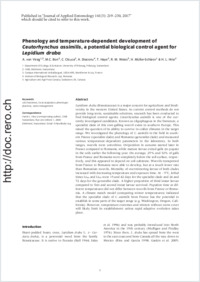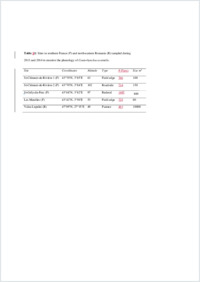Phenology and temperature‐dependent development of Ceutorhynchus assimilis, a potential biological control agent for Lepidium draba
- Virag, A. von Department of Ecology and Evolution, University of Fribourg, Fribourg, Switzerland - CABI, Delémont, Switzerland
- Bon, M.C. Campus International de Baillarguet, USDA-ARS, Montferrier le Lez, France
- Cloşca, C. CABI, Delémont, Switzerland
- Diaconu, Alecu Institute of Biological Research, Iaşi, Romania
- Haye, T. CABI, Delémont, Switzerland
- Weiss, R. M. Agriculture and Agri-Food Canada, Saskatoon, SK, Canada
- Müller-Schärer, Heinz Department of Ecology and Evolution, University of Fribourg, Fribourg, Switzerland
- Hinz, H. L. CABI, Delémont, Switzerland
-
01.04.2017
Published in:
- Journal of Applied Entomology. - 2017, vol. 141, no. 3, p. 219–230
English
Lepidium draba (Brassicaceae) is a major concern for agriculture and biodiversity in the western United States. As current control methods do not provide long-term, sustainable solutions, research has been conducted to find biological control agents. Ceutorhynchus assimilis is one of the currently investigated candidates. Known as oligophagous in the literature, a specialist clade of this root-galling weevil exists in southern Europe. This raised the question of its ability to survive in colder climates in the target range. We investigated the phenology of C. assimilis in the field in southern France (specialist clade) and Romania (generalist clade) and measured various temperature-dependent parameters in the laboratory. In both ranges, weevils were univoltine. Oviposition in autumn started later in France compared to Romania, while mature larvae exited galls (to pupate in the soil) earlier the following year. On average, 25% and 32% of galls from France and Romania were completely below the soil surface, respectively, and this appeared to depend on soil substrate. Weevils transported from France to Romania were able to develop, but at a much lower rate than Romanian weevils. Mortality of overwintering larvae of both clades increased with decreasing temperature and exposure time. At −5°C, lethal times Lt50 and Lt95 were 15 and 42 days for the specialist clade and 26 and 72 days for the generalist clade. A higher proportion of third instar larvae compared to first and second instar larvae survived. Pupation time at different temperatures did not differ between weevils from France or Romania. A climate match model (comparing winter temperatures) indicated that the specialist clade of C. assimilis from France has the potential to establish in some parts of the target range (e.g. Washington, Oregon, California). However, temperature extremes and winters without snow cover will likely limit its establishment unless rapid adaptive evolution takes place.
- Faculty
- Faculté des sciences et de médecine
- Department
- Département de Biologie
- Language
-
- English
- Classification
- Biological sciences
- License
-
License undefined
- Identifiers
-
- RERO DOC 288902
- DOI 10.1111/jen.12322
- Persistent URL
- https://folia.unifr.ch/unifr/documents/305569
Other files
Statistics
Document views: 115
File downloads:
- pdf: 190
- Supplementary material: 109

